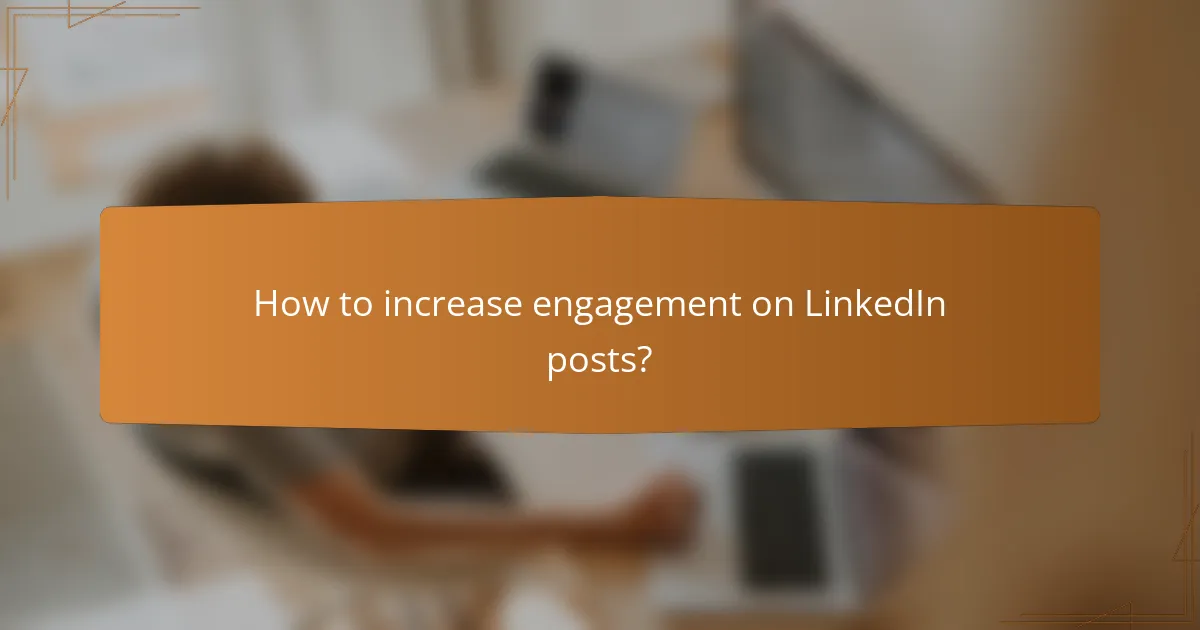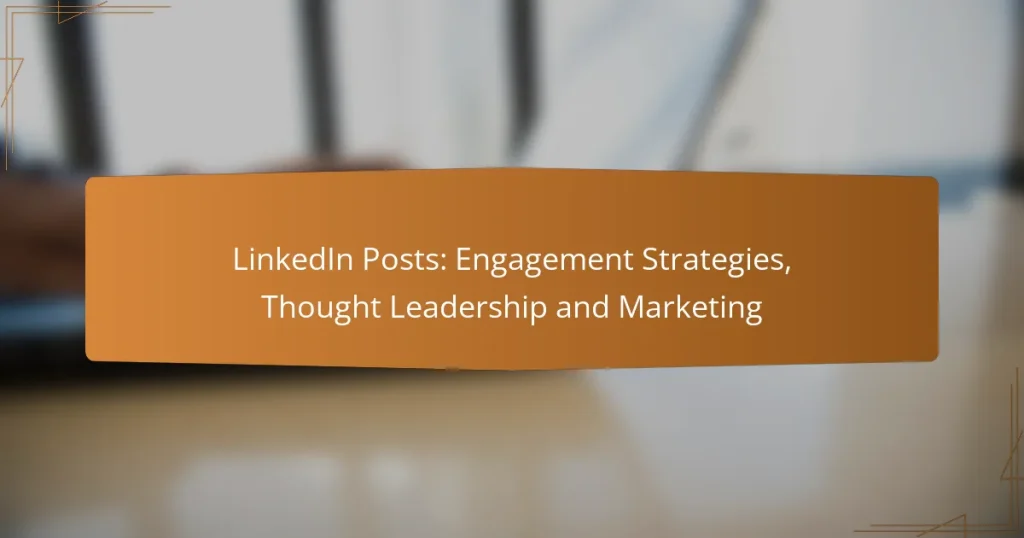Engaging your audience on LinkedIn requires a strategic approach that emphasizes interaction and valuable content. By incorporating visuals, asking thought-provoking questions, and sharing insights, you can significantly enhance engagement. Additionally, establishing yourself as a thought leader through consistent, original content will help build authority and foster connections within your professional network. Leveraging LinkedIn for marketing further amplifies your reach, allowing you to connect with targeted audiences effectively.

How to increase engagement on LinkedIn posts?
To boost engagement on LinkedIn posts, focus on creating content that resonates with your audience and encourages interaction. Effective strategies include using visuals, asking questions, sharing insights, utilizing polls, and tagging connections.
Use engaging visuals
Incorporating visuals such as images, infographics, or videos can significantly enhance engagement on your LinkedIn posts. Posts with visuals tend to receive higher interaction rates, as they capture attention more effectively than text alone.
When selecting visuals, ensure they are relevant to your content and of high quality. Aim for a mix of original graphics and curated images that align with your brand’s message.
Ask open-ended questions
Asking open-ended questions invites your audience to share their thoughts and experiences, fostering a sense of community. These questions should be thought-provoking and relevant to your industry to encourage meaningful discussions.
For example, instead of asking, “Do you like this product?” consider phrasing it as, “What features do you think are essential for a product like this?” This approach can lead to richer engagement and diverse perspectives.
Share industry insights
Sharing valuable industry insights positions you as a thought leader and encourages others to engage with your content. Focus on trends, challenges, or innovations that resonate with your target audience.
Consider summarizing recent reports or studies, or sharing your personal experiences and lessons learned. This not only adds value but also invites others to share their insights in response.
Utilize LinkedIn polls
LinkedIn polls are an interactive way to engage your audience and gather opinions on relevant topics. They are quick to create and can provide valuable feedback while encouraging participation.
When designing a poll, keep the questions straightforward and relevant to your audience’s interests. Aim for a balance between fun and informative topics to maximize engagement.
Tag relevant connections
Tagging relevant connections in your posts can increase visibility and engagement by notifying those individuals and encouraging them to interact. This strategy works well when sharing insights or asking for feedback.
However, be mindful not to over-tag or include individuals who may not find the content relevant, as this can lead to disengagement. Aim for a few key connections who are likely to contribute meaningfully to the discussion.

What are effective thought leadership strategies on LinkedIn?
Effective thought leadership strategies on LinkedIn involve sharing valuable insights and expertise that resonate with your audience. By consistently providing original content and engaging with your network, you can establish authority and foster meaningful connections.
Share original research
Sharing original research on LinkedIn can significantly enhance your credibility as a thought leader. This could include surveys, data analysis, or industry reports that provide unique insights. Aim to present findings in a visually appealing format, such as infographics or summary tables, to capture attention.
When sharing research, ensure it is relevant to your audience’s interests and challenges. Highlight key findings and implications, and invite discussion to encourage engagement. This approach not only showcases your expertise but also positions you as a go-to resource in your field.
Publish long-form articles
Long-form articles allow you to delve deeply into topics relevant to your industry, providing comprehensive insights and analysis. Aim for articles that are at least 1,500 words, as longer content tends to perform better in terms of engagement and shares. Use headings, bullet points, and images to break up text and improve readability.
Consider addressing common pain points or emerging trends in your articles. Incorporating personal anecdotes or case studies can make your writing more relatable and engaging. Promote your articles through your network and relevant LinkedIn groups to maximize visibility.
Participate in discussions
Active participation in discussions on LinkedIn can help you build relationships and showcase your expertise. Engage in relevant groups or comment on posts within your network, offering thoughtful insights or asking questions that stimulate conversation. This not only increases your visibility but also demonstrates your knowledge.
Be mindful of the tone and context of discussions. Aim to add value rather than simply promoting your own content. Consistent engagement can lead to meaningful connections and opportunities for collaboration.
Highlight case studies
Highlighting case studies is an effective way to demonstrate your expertise and the impact of your work. Choose case studies that showcase successful outcomes or innovative solutions to industry challenges. Present them in a clear format, detailing the problem, your approach, and the results achieved.
Use visuals, such as charts or before-and-after comparisons, to illustrate key points. Sharing these stories not only builds credibility but also provides tangible examples of your capabilities, making it easier for potential clients or partners to understand the value you offer.

How to leverage LinkedIn for marketing?
Leveraging LinkedIn for marketing involves utilizing its professional network to reach targeted audiences effectively. By employing strategies such as targeted ad campaigns, engaging in groups, optimizing your company page, and sharing testimonials, businesses can enhance their visibility and credibility on the platform.
Create targeted ad campaigns
Targeted ad campaigns on LinkedIn allow businesses to reach specific demographics based on job title, industry, location, and interests. This precision helps ensure that your marketing messages are seen by the most relevant audience, increasing engagement rates.
Consider using Sponsored Content, InMail, or Text Ads to promote your products or services. Start with a modest budget and monitor performance metrics to refine your approach over time, focusing on ads that yield the highest return on investment.
Utilize LinkedIn Groups
LinkedIn Groups provide a platform for professionals with shared interests to connect and discuss relevant topics. Joining or creating groups related to your industry can help you engage with potential customers and establish your authority.
Actively participate in discussions by sharing insights and answering questions. This not only builds relationships but also positions your brand as a thought leader. Aim to contribute valuable content regularly to maintain visibility within the group.
Optimize company page
Optimizing your LinkedIn company page is crucial for attracting followers and potential clients. Ensure that your page is complete with a compelling description, logo, and banner image that reflects your brand identity.
Regularly update your page with fresh content, including articles, job postings, and company news. Utilize keywords relevant to your industry to improve search visibility, and encourage employees to engage with and share your content to expand your reach.
Share customer testimonials
Sharing customer testimonials on LinkedIn can significantly enhance your brand’s credibility. Positive feedback from satisfied clients serves as social proof, encouraging potential customers to trust your products or services.
Consider creating visually appealing posts or videos that highlight these testimonials. Tagging the customers involved can increase engagement and reach, as their networks may also see the content. Aim to share testimonials consistently to keep your audience engaged and informed.

What metrics should you track for LinkedIn post performance?
To effectively measure LinkedIn post performance, focus on key metrics such as engagement rate, click-through rate, follower growth, and conversion rate. These metrics provide insights into how well your content resonates with your audience and its overall impact on your marketing goals.
Engagement rate
Engagement rate reflects the level of interaction your posts receive, including likes, comments, and shares. A higher engagement rate indicates that your content is resonating with your audience, which is crucial for building a strong presence on LinkedIn.
To calculate engagement rate, divide the total interactions by the total impressions and multiply by 100. Aim for an engagement rate in the low to mid-single digits as a benchmark, but remember that this can vary by industry.
Click-through rate
Click-through rate (CTR) measures the percentage of users who click on links within your posts. A higher CTR suggests that your content is compelling enough to prompt users to take action, such as visiting your website or reading more about a topic.
To calculate CTR, divide the number of clicks by the total impressions and multiply by 100. A good CTR on LinkedIn typically ranges from 2% to 5%, but this can depend on the quality of your content and the relevance to your audience.
Follower growth
Follower growth indicates how your audience is expanding over time, which is essential for increasing your reach on LinkedIn. Tracking this metric helps you understand the effectiveness of your content strategy and overall brand appeal.
Monitor follower growth monthly to identify trends and spikes that correlate with specific posts or campaigns. A steady increase in followers is a positive sign, while stagnation or decline may require a reevaluation of your content strategy.
Conversion rate
Conversion rate measures the percentage of users who take a desired action after engaging with your posts, such as signing up for a newsletter or making a purchase. This metric is vital for assessing the effectiveness of your LinkedIn marketing efforts in driving business objectives.
To calculate conversion rate, divide the number of conversions by the total clicks and multiply by 100. A conversion rate of 1% to 3% is generally considered acceptable, but aim for higher rates by optimizing your calls to action and ensuring your content aligns with audience needs.


